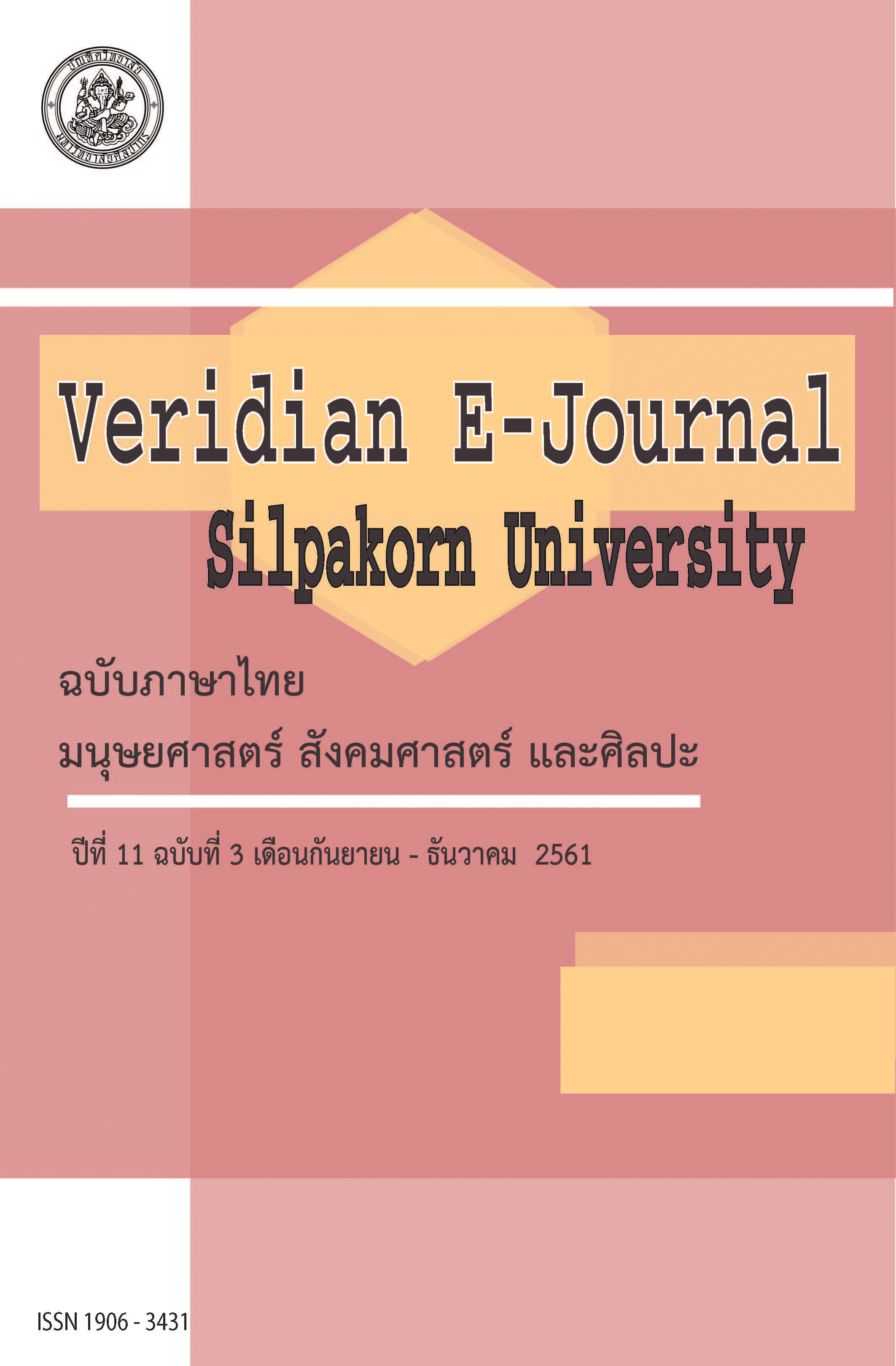สิ่งอำนวยความสะดวกที่เหมาะสมและปลอดภัยเพื่อผู้สูงอายุและผู้พิการกับการพัฒนาคุณภาพชีวิตสร้างความเสมอภาคในสังคม: กรณีศึกษาชุมชนชาติพันธุ์ บนพื้นที่สูงจังหวัดเชียงราย (Safe and Appropriate Facilities for the Elderly and the Disabledwith the Development of the Quality of Life and Social Equality: A Case Study of Highland Ethnic Communities in Chiang Rai Province)
Main Article Content
Abstract
งานวิจัยนี้เป็นการวิจัยเชิงคุณภาพ มีวัตถุประสงค์เพื่อศึกษารูปแบบสิ่งอำนวยความสะดวกที่รัฐจัดบริการ การเข้าถึงสิ่งอำนวยความสะดวก และรูปแบบสิ่งอำนวยความสะดวกที่เหมาะสมและปลอดภัยสำหรับผู้สูงอายุและผู้พิการภายใต้บริบทชุมชนชาติพันธุ์บนพื้นที่สูงในจังหวัดเชียงราย เลือกกลุ่มตัวอย่างแบบเฉพาะเจาะจงจากผู้ให้ข้อมูลสำคัญ เป็นผู้สูงอายุ ผู้พิการ ผู้ดูแลผู้สูงอายุและผู้พิการ ผู้นำชุมชน เจ้าหน้าที่องค์กรปกครองส่วนท้องถิ่นและเจ้าหน้าที่หน่วยงานภาครัฐ รวม 73 คน เก็บรวบรวมข้อมูลโดยการสัมภาษณ์เชิงลึกจากแบบสัมภาษณ์แบบมีโครงสร้าง การสังเกต และการสนทนากลุ่มย่อย ทำการวิเคราะห์ข้อมูลโดยใช้การวิเคราะห์สรุปอุปนัย (Analytic Induction) และสร้างข้อสรุปเพื่อหาคำตอบตามรายวัตถุประสงค์
ผลการวิจัยพบว่า รูปแบบสิ่งอำนวยความสะดวกที่รัฐจัดบริการให้กับผู้สูงอายุและผู้พิการชุมชนชาติพันธุ์ในสถานที่ราชการคือ ศาลากลางจังหวัด ที่ว่าการอำเภอ ที่ทำการขององค์กรปกครองส่วนท้องถิ่น สถาบันการศึกษา สถานีตำรวจ และโรงพยาบาล ในชุมชนจัดสร้างห้องน้ำและลานจอดรถขึ้นในศูนย์พัฒนาราษฎรบนพื้นที่สูง และในบ้านที่พักอาศัยมีการปรับปรุงบ้านที่พักอาศัยและห้องน้ำสำหรับผู้พิการ
การเข้าถึงสิ่งอำนวยความสะดวกที่เหมาะสมและปลอดภัยของผู้สูงอายุและผู้พิการในสถานที่ราชการ โรงพยาบาลอำเภอ โรงพยาบาลส่งเสริมสุขภาพตำบล และองค์กรปกครองส่วนท้องถิ่น การใช้ประโยชน์สิ่งอำนวยความสะดวกที่รัฐจัดบริการมากที่สุด คือ ห้องน้ำ ทางลาด และบันได ในชุมชนสร้างสิ่งอำนวยความสะดวกขึ้น
ณ ศูนย์พัฒนาราษฎรบนพื้นที่สูง ผู้สูงอายุและผู้พิการมีโอกาสในการเข้าถึงน้อยมาก การใช้ประโยชน์ไม่เป็นไปตามวัตถุประสงค์และเจตนารมณ์ของหน่วยงาน และในบ้านที่พักอาศัย มีการปรับปรุงบ้านให้เหมาะสมและปลอดภัยกับผู้พิการโดยให้ผู้พิการเป็นผู้เลือกรูปแบบบ้านและห้องน้ำที่จะปรับปรุงภายใต้งบประมาณที่กำหนด
รูปแบบสิ่งอำนวยความสะดวกที่เหมาะสมและปลอดภัยกับผู้สูงอายุและผู้พิการภายใต้บริบทชุมชนชาติพันธุ์ ในสถานที่ราชการมีการจัดสร้างสิ่งอำนวยความสะดวกอย่างครบถ้วนตามกฎกระทรวง เรื่อง การกำหนดสิ่งอำนวยความสะดวกในอาคารสำหรับผู้พิการหรือทุพพลภาพและคนชรา พ.ศ. 2548 และพระราชบัญญัติควบคุมอาคาร พ.ศ. 2522 แต่ควรมีการดูแลรักษาให้ใช้งานได้อย่างมีประสิทธิภาพ เน้นความสำคัญในการเข้าถึงการใช้งาน จัดเจ้าหน้าที่เพื่อให้บริการ การประชาสัมพันธ์การใช้งานที่ถูกต้องเหมาะสมและสร้างความเข้าใจร่วมกับชุมชน ลดความเหลื่อมล้ำหรือแบ่งแยกในการอยู่ร่วมกัน ในชุมชนควรจัดสร้างขึ้นในสถานที่เป็นศูนย์รวมการทำกิจกรรม และในบ้านที่พักอาศัยควรให้ความสำคัญในประเด็น ห้องน้ำ ทางลาดเชื่อมระหว่างห้องน้ำและตัวบ้าน ที่นอน อุปกรณ์และสิ่งอำนวยความสะดวก และการแนะนำการใช้งาน
This qualitative research is aimed to explore the pattern of the Facilities that the government provided, their accessibility, and their design for the elderly and the disabled persons under the context of highland ethnic communities in Chiang Rai Province. The 73 sampling population including the aged persons; disable persons; caregivers; community leaders; and officials from the local administrative organizations and governments were selected from the key informants by purposive sampling method. Data were collected by in-depth interviews by structured interviews, observations, and focus group discussions. The Analytic Induction was also used to analyze the data, then conclusions were drawn for each objective.
The findings revealed that for the elderly and disable persons living in the ethnic communities, the pattern of the Facilities government provided was limited in the government compounds including the provincial halls, district offices, offices of the local administrative organizations, educational institutions, police stations, and hospitals. In the community, toilets and car parks were built in the compounds of the Highland People Development Center. The residence units, including living areas and restrooms, had been properly renovated for the disabled persons.
From the aspect of the accessibility on the safe and appropriate Facilities in the government compounds; district hospitals; sub-district health promoting hospitals; and local administrative organizations, the most usability on the Facilities were the restrooms, ramps, and stairways. In the communities, the aged persons and disabled persons had rarely access or use universal designed facilitation at the Highland People Development Center brought no fulfillment of the objectives and intention of the agency. Also, residences had been renovated under the light budget in order to bring the suitability and safety for the disabled persons who would rather choose the style of the house and bathroom of their own.
For the elderly and the disabled persons under the context of ethnic communities, the safe and appropriate Facilities in the government compounds were completely built to meet the requirements by the Ministerial Regulations: the Specification of the Facilities of Building for Disable Persons and Aged Persons, B.E. 2548 (2005), and the Building Code B.E. 2522 (1979), but these should be maintained for effective application, emphasizing the importance of accessibility for usability, providing good services and proper advices as well as creating comprehension with the communities, in order to decrease the difference or discrimination in coexistence. Moreover, the built Facilities in the communities, especially in the co-activity space, and residences should be emphasized on the toilets, transitional ramps connection the toilets to the houses, beds with proper equipment and usability manuals.
